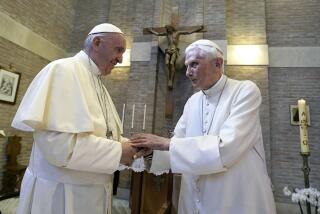Pontiff Updates Code for Electing Popes
- Share via
Pope John Paul II issued an updated code Friday for electing popes, introducing modern comforts for cardinals and reaffirming rules against electronic bugging and cellular phones to safeguard the conclave’s secrecy.
In his new apostolic constitution “Universi Dominici Gregis” (The Shepherd of the Lord’s Whole Flock), the pope reaffirmed that cardinals 80 and older cannot enter a conclave to elect a pope. He also kept the upper limit for the number of cardinal-electors to 120.
At a news conference presenting the 63-page document, a Vatican official said he did not know if the traditional way of telling the world of the election of a new pope--white smoke from the chimney of the Sistine Chapel--would be maintained.
Conclaves are called to elect a new pope between 15 and 20 days after the death of a reigning pontiff. Only cardinals can choose a pope, usually from among their own ranks.
The Vatican said the 75-year-old pope, who has suffered a colon tumor and broken leg in recent years, was in fine health.
“I can see the pope is in perfect health. . . . This document has nothing to do with that particular personal situation,” said Bishop Jorge Mejia, secretary of the College of Cardinals.
The pope ruled that while balloting will still take place in the Sistine Chapel, the cardinals will reside in a new residence in Vatican City.
The word conclave comes from the Latin cum clave, which means with a key, because cardinals are locked away from the outside world.
Mejia also said the traditional use of white or black smoke to signal whether the cardinals had elected a pope or not had a “more or less folkloric meaning and I don’t know if this or another method will be used.”
In recent centuries, cardinals--even elderly ones with health problems--have been locked up in makeshift cells around the chapel, which is decorated with Michelangelo’s frescoes.
In the future they will stay in the new St. Martha residence, which has single rooms and private baths, and be transported to the Sistine for each voting session.
The document reaffirmed strict rules of secrecy laid down by Pope Paul VI in 1975 that forbade cardinals from bringing electronic equipment into the conclave.
The pope said two “trustworthy technicians” should check that no sound or video transmitting devices had been smuggled into the conclave area. Cellular phones would be included in the ban, Mejia said.
“I further confirm by my apostolic authority, the duty of maintaining the strictest secrecy with regard to everything that directly concerns the election process itself,” he wrote.
The document reaffirmed rules requiring cardinals and those who help them during conclaves to take oaths of secrecy and have no contact with the outside world unless in an emergency.
It eliminated two rarely used and ancient methods of voting during the elaborate conclave.
One is by acclamation, which allowed for the possibility that the cardinals, under the influence of the Holy Sprit, would say aloud and together the name of the cardinal to become pope.
The other method eliminated was by compromise, which allowed for cardinals in a hung conclave to delegate the election to a committee from among their own ranks.
John Paul ruled that a pope can be elected only by the traditional method--a two-thirds majority--and if that failed after seven ballots, an absolute majority.
The document outlined elaborate details of how the church was to be run until a successor is elected, including instructions on what cardinals should wear during the nine days of mourning.
After a pope dies, his “fisherman’s ring” and the lead seal used for official documents are destroyed. His private apartments are sealed until the election of a new pope.
More to Read
Sign up for Essential California
The most important California stories and recommendations in your inbox every morning.
You may occasionally receive promotional content from the Los Angeles Times.










